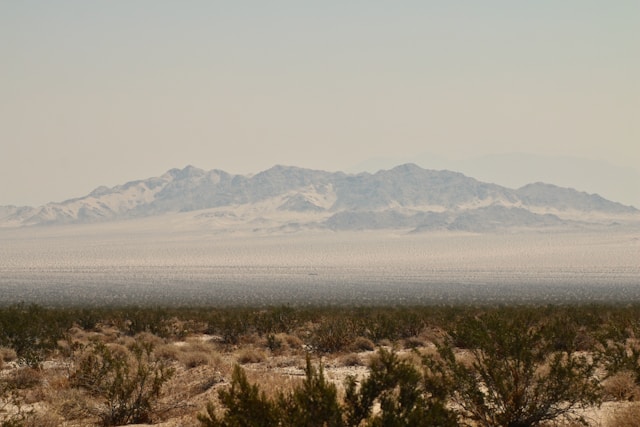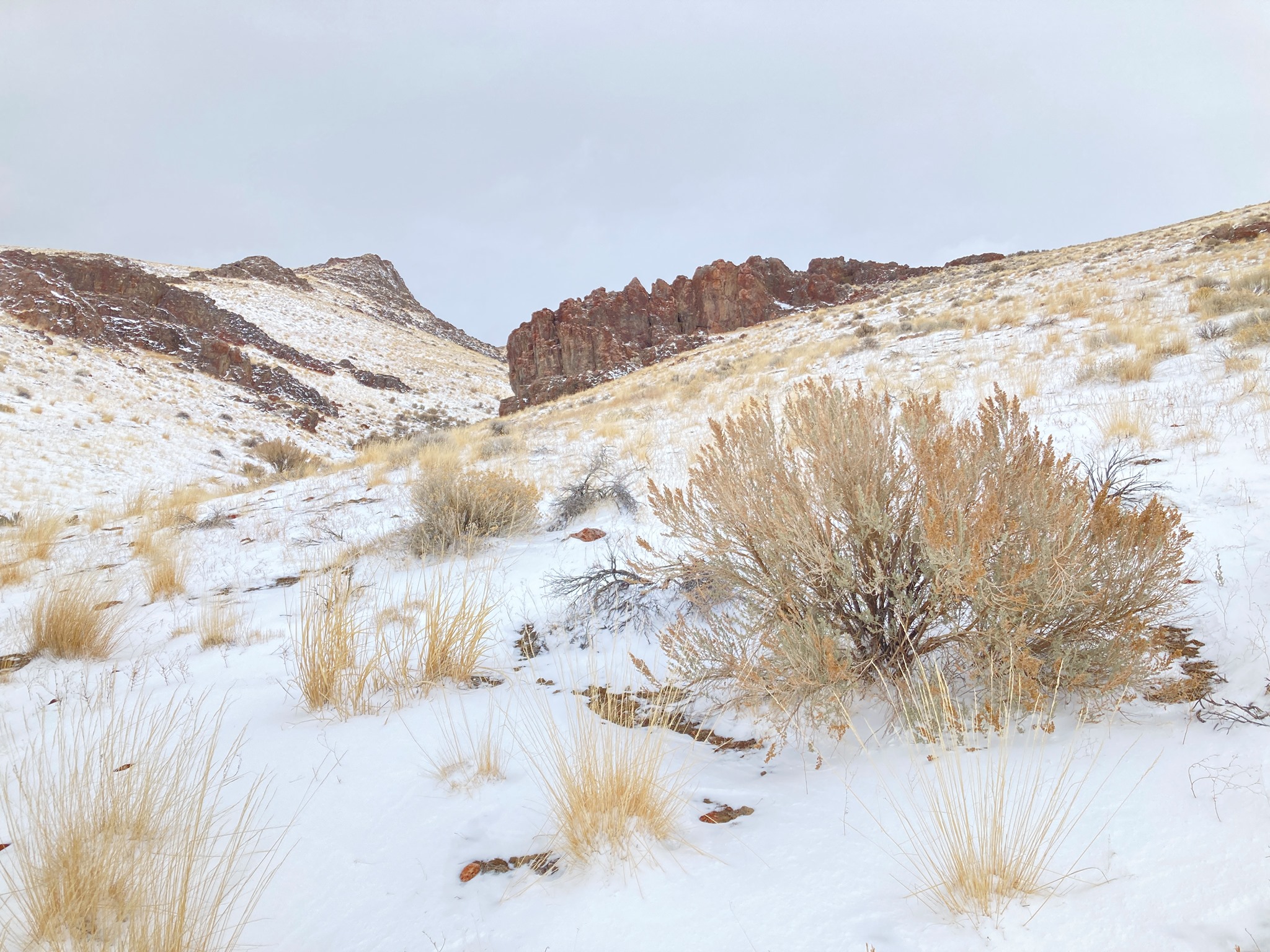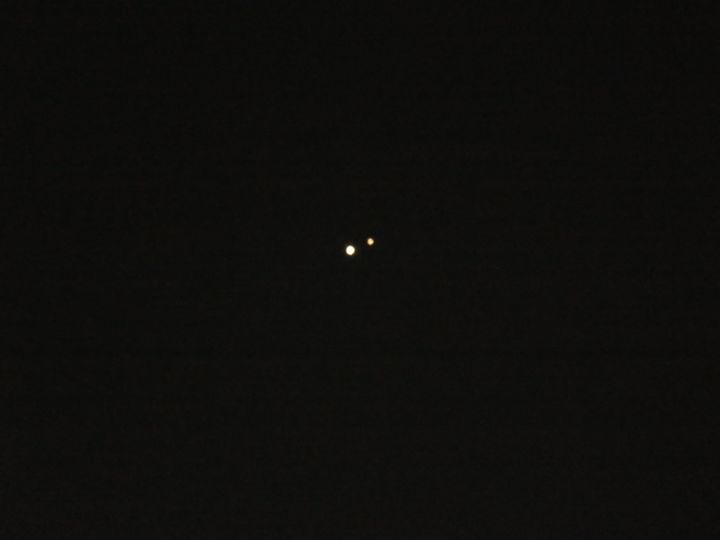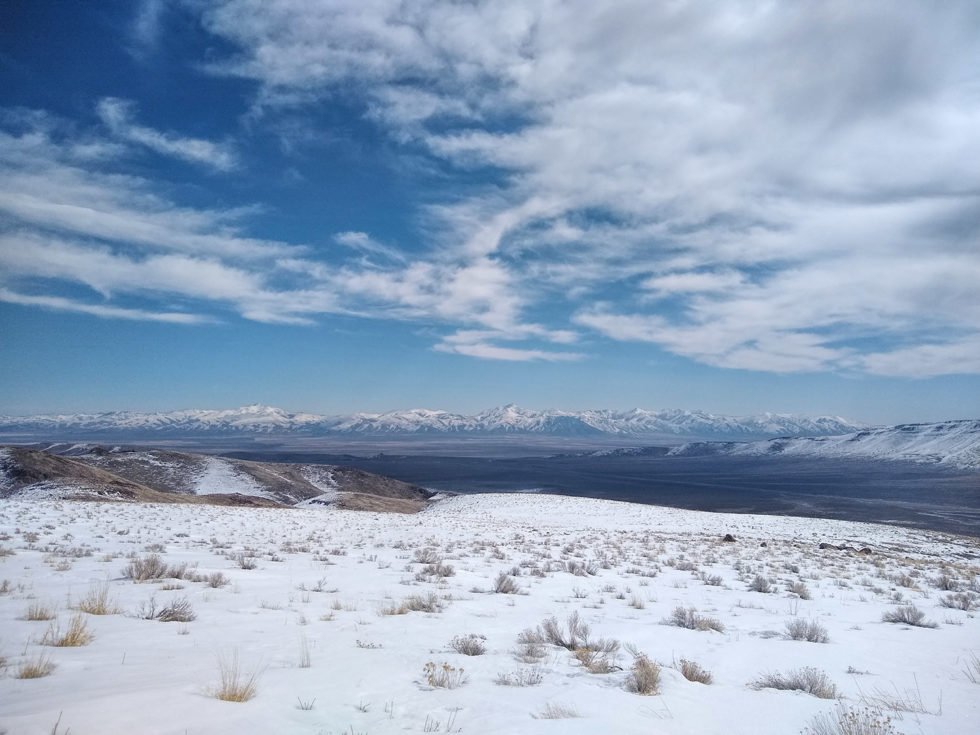
by DGR News Service | Mar 21, 2021 | Biodiversity & Habitat Destruction, Climate Change, Listening to the Land, Mining & Drilling, Movement Building & Support, The Problem: Civilization
In this article, Kelli Lundin describes her experience at Thacker Pass and the culmination of her analysis that every landscape deserves sovereignty for its own sake.
By Kelli Lundin
I’ve always found my attempts quite taboo in trying to put my experiences into a container—such as words. How can any arrangement of words, especially mine, fully describe feelings, emotions, visions, colors, dreams—or in particular, Life from the perspective of a specific place? My experience at Thacker Pass holds for me the same dilemma. What can be said of such a place to make a difference in the hearts of others? How can I describe with words something so sacred, something so elemental, something so necessary that it merits protection, honor, and reparations from us all?
What comes to mind is this: every place, whether it be Thacker Pass or any other Landscape, deserves sovereignty for its own sake, or rather, IS sovereign. Land, like any other body, is its own, just like mine and yours, the Songbird’s, the Sage Brush, every body of water, every mountain, woodland, valley, and prairie.
I am reminded of what Friedrich Schelling once wrote,
“First, and above all, an explanation must do justice to the thing that is to be explained, must not devalue it, interpret it away, belittle it, or garble it, in order to make it easier to understand…”
Words, I feel, (or again, at least mine) never fully justify, explain, or have the ability to assign value to what is Sacred. And like Thomas Berry said,
“There are no unsacred places; there are only Sacred places and desecrated places.”
Thacker Pass is Sacred.
And, I believe what weaves throughout all sacredness, or literally what defines the Sacred, is Relationship. Here in the high landscapes nestled amongst Mountains and Valleys, relationships abound in abundance. These relationships are so intimate—my voice, my thoughts, my very presence feels intrusive. Being in this place, my eyes wide open, I am in awe. My heart relaxes, my mind empties, and I feel at home in a quiet comfort that is rarely afforded to me.
I wander in solitude, and the wild of this place soothes the ache and loneliness I find in the city, the noise and bustle of everyday goings-on. The sound of Ravens, Chukars, Coyotes, Rain, and the explicit emotions of Wind repair and bring back to Life all my senses. The ever-constant numbness that protects me from the underlying and overwhelming grief of all that I know, slowly fades. I feel again, what it is to be alive.
I trail them—Deer, Coyote, the flight of a Sage Grouse, Bobcat, Mouse, even a Mountain Lion and wonder about their lives—what they know, how they feel, the meanings of their songs. I also wonder, “how do the sounds of my song inspire others?”
I have seen the spectrum of desecration swing from dismissiveness, blatant willful ignorance and callousness, all the way to blasting, shredding and annihilating bodies to dust, leaving death forever more in its wake. Lithium Americas wants to obliterate Thacker Pass. It doesn’t matter that they have a reason. It’s not their body. It’s not their Lithium. It belongs to the land. It’s Hers for her own purpose.
Does it take being raped and knowing that experience to empathize with the raping of Land or any body that is being taken from, used, resourced, controlled, exploited, or any other word describing desecration? I don’t know. What I do know is this: rape equals death. Something dies that is never reborn and no amount of grief will ever bring it back.
When will we all see this with our own eyes?
ALL of Life is depending on us to open our eyes and hearts to see the Sacred, in us and all around us. Death is one thing, but the end of birth is entirely something else.
For me, it all comes down to one word. Love (verb): to give Life, protect Life, honor Life, to see all Life as Sacred. For every Body.
Thank you Will Falk and Max Wilbert for continuing to offer justice, through your words and actions, that speak to the truth of how I feel and what I know. I’m so proud of you both. You are true humans being. Your courage is remarkable and a clear demonstration of how we all can expand our awareness in knowing every Body as Sacred.
Kelli Lundin is an environmental activist, land defender and writer.
You can find out more and support Thacker Pass:

by DGR News Service | Mar 13, 2021 | Biodiversity & Habitat Destruction, Human Supremacy, Listening to the Land, The Problem: Civilization
This essay is a firsthand account of the author Michael Drebert’s visit to Boundary Bay, BC — a shallow bay fringed in-part by a man-made dike, and estuarine marsh. Through his recollection of the visit, Drebert discusses how different forms of ‘taking’ from a particular place can be both obvious, but also inconspicuous. Most importantly, the essay asks what a meaningful response to such activities might entail.
Keywords: physical world, place-based, wetlands, memory, story, political resistance, reciprocity, kinship
Boundary Bay: A Place Divided
By Michael Drebert
Last week, I decided to throw my bicycle into the back of my ancient Ford truck and head south out of the city. My destination was a place that I’ve been visiting since youth: Boundary Bay, a shallow body of saltwater spanning the municipalities of Tsawassen, Delta, Surrey, and White Rock.
It’s the White Rock portion of the bay that I recall from my youth. My grandmother would take my brother and I to its beach during summers, where we’d be allowed to range freely over the massive stretch of exposed sand at low tide. For hours, we’d wade into the warm tide pools, chasing sculpins, and small crabs. But the prize activity, was the building of a sand fort. Together, or apart, we’d spend what seemed like an entire day constructing raised platforms of sand that were then walled as best we could against the incoming tide. It was pure joy to be sitting in our ‘forts’ as the quickly approaching water of Boundary Bay moved towards us.
Thirty-five years later, I still return to the bay.
Less so to that stretch of perfect sand, but instead to an area on the opposite side. My excitement remains the same as in those early years, except that my attention has now shifted from its sand flats, to its mud flats.
In this section of the bay, there are preserved portions of what would have originally been coastal salt marsh. Less than 100 years ago, this form of habitat would have been prominent around the entire bay. With the influx of settlement by Europeans, residences were built along the shoreline. Attracted by, and taking advantage of the fertile, alluvial soils, these settlers engaged in intensive farming activities. As a result, dikes were built around the majority of the bay to protect the farms. These constructions cut off the usual flow of biological activity between the what is now the seaward, and landward portions of the salt marsh. Although some culverts were also inserted, these semi-permeable structures equally separated the two places, blocking fish, and small mammals from freely traversing back and forth.
Regardless of all these intrusions, a fringe of intact wetland still exists here.
I consider it a gem, and it has captured my heart. Martin Shaw describes the mysterious process of being attracted to a place as being “claimed.”1 And so, I might say something like: this particular shallow body of water, with its fringe of brown-sand beaches, and scruffy marshes, has claimed me. This is a romance that has been in the works for over 35 years.
On that blustery December day last week, after driving out of Vancouver over a couple of bridges, past farmland, eventually parking at Centennial Beach on the west side of the bay, I came to spend an entire day considering my attraction to such a place, and how I might best respond. And now, reflecting on this memory, another relationship to that place emerges: ‘taking’, in this case my ‘taking’ of this remembrance from Boundary Bay. I think about how so often, on my countless visits to different beaches around my home of Vancouver, and also abroad, I’d pick up some stone, or shell that ‘spoke’ to me. If it ‘spoke’ to me enough, I’d usually put it into my pocket, and carry it home. Once inside of my apartment, it would sometimes sit on a shelf, or placed in a box along with a clattering and dusty array of other mineral, and calcerific objects.
For over 35 years, I’ve barely questioned this.
“Of course,” I’d say to myself, “why wouldn’t I take a token to remember a special moment, a special place?” In particular, I have a small collection of agate stones that I collected from different beaches on Haida Gwaii. They now sit in a circle formation on the window sill of my bedroom. Whenever I look at them, my mind seems to become awash in something; something like the wind, or the sun, or the intermittent heavy rains that would pass over the lonely beaches around Rose Spit. So yes, that does have meaning for me, some connection to natural processes that are nearly impossible to express within language.
Even if I’ve taken these things to help me remember a particular place — and although they are often compelling in their own right, as objects outside the context that I found them in — were they not also beautiful on some rain-drenched beach? Were they not beautiful to someone else? Or useful, or necessary?
I want to compare this piece of writing and the memories it expresses to these taken objects — no different then a found cockle shell, or a set of fine, sun bleached bones that belonged to a western sandpiper. My 40-something year old body had to be there, in Boundary Bay — where one object encounters another, or, a material presence, encounters another material presence.
In other words, this essay would be impossible without the physical presence of my body making its way 50 kilometres south, out of Vancouver, where I met the earthen barriers which surround the bay. And once there, riding on my bicycle all day until the sun went down, sweating heavily beneath my Gore-Tex jacket and breathing in cold air which also made my eyes tear.
So, yes, I do believe I’ve taken something.
And, it’s not that I think this is entirely wrong, because all living things take things out of need, survival, happenstance. But usually, for the whole cycle to continue giving, and taking, it has to happen, in one place, or, it must circle back to the very place that the thing was taken from. Using a more more poetic sensibility, Gary Snyder posits another way of saying this: that in acknowledging our (human) need to consume, it would be proper etiquette to then offer a “[s]ong for your supper,”2 in respectful response.
The consequences of taking from somewhere and never giving back are, of course, obvious. Eventually, there is little left to glean, and eventually, when we move beyond the limits of particular places, they break. When it comes to material items, it’s easy enough to understand when there is a failure of reciprocity, but I think this same sentiment can be also be applied to ‘getting’ stories, as well.
To get this story (an account of some place where I do not live), I needed to go somewhere. This inevitably, and perhaps obviously implies ‘using’. My body needs certain things so that it can go places — it needs food, water, clothing, transportation. Where do these things come from? In the case of my visit to Boundary Bay, they almost certainly do not come from that place, but they do come from places, very real places.
Back to my very real, ancient truck, and back to that particular day, last week — along with these questions saturating my thoughts, it was also to my journey ahead that my mind now turned. I arrived at Centennial Beach, on the western side of the bay, around 1pm. The sky was grey, and there was a stiff breeze blowing in from the Salish Sea. I was a little nervous. Was this the right day to be attempting such a long bike ride along the dike? Will the weather continue to deteriorate, turning into rain, and stronger winds? There wasn’t time for second guessing. If I was going to do this, I had to leave right away so that I could get back to my truck before the park ranger locked the gates at 5pm. So I gobbled down some hard boiled eggs, and then off I rode heading towards the Serpentine River located at the eastern terminus of the dike.
The wind was unusually cold, biting at my face and neck.
Except for one, very thin line of bright yellow out towards the Gulf Islands, the sky was solid cloud in all directions. Even though all of this felt less-than-ideal, there was no turning back — I was committed. It didn’t take long before I started seeing bald eagles standing on the mudflats, and perched overhead on the power lines. Eventually, it seemed there was an eagle on every pole, and when I passed beneath looking up, the massive raptors would return the stare. This exchange made me shiver in a way to which I was totally unaccustomed. I thought: “What is stopping these creatures from swooping down with their bright yellow feet, tearing at my neck and carrying off a piece of my flesh to be eaten casually on the mudflats?” I’ll admit that one particular stare was so intense that I lost composure on my bike, wobbling as I sensed a feeling of nausea rise in my throat.
Things were different here. Even though I could still see the distant high-rise buildings of Vancouver, it all seemed so fragile, so vulnerable. Or at least I felt vulnerable, coasting along that thin hump of land meant to keep the salt marsh and all of its inconsistencies out of our human hair.
Half way along the dike, I noticed that the sky had lightened. I wasn’t sure that the weather was going to flip towards ‘pleasant’, but I am a sucker for any sign of sun — it can change everything for me. I also wasn’t particularly cold anymore — probably because of my constantly pumping legs over the smooth, gravel path.
Aside from the eagles, I was distracted from my cycling by many other birds.
In particular, the red-tailed hawks, who would casually swoop across the dike looking for food in either the salt marsh, or the farming fields. I also noticed many birdwatchers, carrying cameras with lenses as big as my legs. I was glad to these folks. Perhaps I sensed a kind of kinship. I rarely take composed pictures of wildlife, but I do look, stare, soak in, and strain to store particular sights into my memory. I think it’s a very similar activity, except I cannot claim any craft here, which certainly plays a role in my fellow kin’s activity out there on the marsh.
However, a pang of discomfort hit me as I considered this commonality. Again, back to my thoughts and feelings of ‘taking’ something from a place. No doubt these camera operators are taking something. Taking images, but also, in order to take these snap shots, the very device used to do so contains within it an incredible array of ‘taking’. Those cameras, worth more that two years of my annual income, undoubtedly come from some place else. The industrial processes involved in procuring such materials, always does harm to particular places. Put more succinctly, Lierre Keith states that, “[i]n blunt terms, industrialization is a process of taking entire communities of living beings and turning them into commodities and dead zones.”3
Another example of this process is the building of dikes, in order to facilitate industrial agriculture. To my right, is a living (although greatly diminished) salt marsh, and to my left is a dead zone of industrial processes which includes pesticides, fertilizers, and heavy tilling. One side allows for myriad life forms to flourish, and the other side is manipulated solely for human-use.
Is it too heavy-handed to say that one side is beautiful, and the other, is ugly?
It might be good to return here to my own initial discomfort of being physically present at Boundary Bay. Clearly, I also use harmful things. The most obvious thing being my truck. And so in an exacting sense, Snyder’s admonition is unavoidable for me. Truly, what is my song for my supper? The supper in this case might be all the elements which got me out to Boundary Bay, but also for this feast of the senses which has turned into this essay.
Is this essay then, my song? In part perhaps, but it remains an incomplete melody. On its own, it lacks the consonance of return. What I mean is that as a piece of writing, it remains within the realm of human nourishment, or meaning. At worst, it only increases the echo chamber effect of human culture, further dividing humans from their true responsibilities to the real, material health of particular places. More so, it gives the illusion of a completed cycle, inevitably leading to further breakage, and increased ‘taking’.
The time it took to get to the Serpentine River was more than double than what I anticipated. I allowed myself to forget this momentarily as I was in need of food, tea, and a place to relieve myself. I only took 20 minutes to rest, where I sat on granite boulders gazing out at the exposed mud flats of the Serpentine River estuary.
The sky at this point had completely changed.
Late afternoon sun poured over the bay, and a near full moon was rising. To make it back to the truck before the gates were locked, I would have to increase my speed by double to make it. There wasn’t time to question my ability here. No one else was embarking along the dike towards Centennial Beach. It was likely too late in the day for most people — the temperature dropping, and nearly time for supper. With the bright moon continuing to rise, I raced out back along the dike, my legs pumping with renewed zeal.
Large birds still crossed overhead, but because the light had diminished, they now seemed like very unusual objects. They were vague, but still intimidating, blending with the browns and the purples of a day-about-to-end. There was one exception to this blurring of life, and it was a phenomenon that I’ve witnessed a few times before. Close to sundown, large flocks of western sandpipers appear together over the water’s edge. Not unlike a school of herring will move, their tiny bodies fly together as one shimmering, and amorphous shape. But what makes this particularly shocking to me, is what happens at sunset.
When the sky is pink, and I happen to be facing the direction that can then view their bellies, all of a sudden, I’ll see a burst of tiny pink flashes — their white undersides acting as perfect screens, reflecting the bay’s show of evening light. After witnessing the sandpipers, I could see that the moon had climbed to the top of the sky — against dark indigo, its snowy glow cast a reflection onto the calm waters of the bay. I had just entered the bounds of Centennial Beach, and felt a rush of calm — I made it, just in time.
I only had a few minutes to load my bike.
The park ranger was weaving her truck slowly through the parking lot, orange lights flashing, letting everyone know that the gate closure was imminent. As my truck warmed up, I ate my remaining potato chips — I was utterly famished. Could I stay the night? Perhaps, but my cupboards were in another place. And so with mixed reluctance I drove my old truck out of the park bounds, pointed it northwards, and headed home towards Vancouver.
I’m writing this now, in my studio. I like to have the door open, but the weather is too cold — being mid-winter on the northwest coast. I like the door open so I can feel the breeze, and to better hear the bird calls. Though, because my yard and my neighbour’s yard are packed with plants, there are a lot of birds present regardless of the season. And even though the door is closed, I can still hear intermittent chirps, trills, and lilts. I don’t know what I would do without this lush garden, and all the visiting animals. Living in the city would be impossible, otherwise.
Given just a little more thought, my appreciation of this garden can flip, completely. In short: the horrors of the city are made acceptable, because of this tiny retreat. Take away my access to this, and I am a very different person. Even a degraded version of ‘land’ lends me the needed salve to continue an urban life. Less a salve perhaps than a balm, for I cannot attribute any medicinal qualities to its makeup.
This quality makes me think about the Tsawassen and Semiahmoo peoples who inhabited Boundary Bay long before European settlers.
It would seem that true medicine is ‘offered’ to those who live in a particular place, so that they can continue living well in that particular place. Not to heal, and then leave. I would say that pocketing a unique shell, collecting an image in a camera, storing an experience in your mind and heart to be retold later, is similar to this ‘leaving’ experience. It is a draining off of life, taken from a place where it has no opportunity to perish, to decompose, to nurse new life — it breaks the elegance of a necessary cycle.
I don’t live at Boundary Bay, on the ‘right side’ of the dike. That would be impossible, mostly. My fumbling attempts at trying to hunt, forage, and build shelter would no doubt further harm that place. And so, in-line with my interest to pay for my debt of visitation, I decide to pause, and attempt to ask Boundary Bay: what is it you might want, or need? Although my asking is somewhat awkward — sitting in this small studio miles away — one answer comes surprisingly quickly: simply remove the poison.
In the physical, material world, poison is always harmful, and in many cases, deadly. What then might the material poisons in this particular place be? The dike which stretches along the bay, is a simple technology, but it only serves one species. It is effective, very effective in separating the wild processes, from the hyper domesticated processes of city living. But the harm of this dike, the poison of its material intrusion, affects thousands of species, negatively.
Pausing at my desk, my mind flickers back to those childhood memories of my brother and I building sand forts at White Rock Beach. During those countless afternoons, I would often glance back at my grandmother. She was usually sitting in a collapsible deck chair, perched on a sand bar — her oversized sunglasses turned in our direction — and always smiling. As the tide quickly approached, we rushed to complete our forts feeling safe, completely safe.
Even then, I knew that our efforts to keep the cool saltwater at bay, were ultimately futile, that our constructions would eventually collapse.
But still we did our best to play the game: whose fort would last the longest? I count these as some of the most fun, and enjoyable moments of my entire life. If an incoming tide ever began to break up the dike at Boundary Bay, I don’t think I’d be sad, or frustrated. I might even smile: understanding that this is how it should go, that this is natural, or helpful. I might also recognize my kinship with the cool saltwater of the bay, and decide in my own way how to lend-a-hand.
And while I did this work, I might even sense the smile of something, or someone, much older than I: her calm and caring love taking delight in the work of her family. Perhaps then, simply: acts which remove poisons, could be our songs for our supper — a chorus of gratitude for the gift of being alive. And perhaps this kind of singing will attract others to the work, creating meaning and social bonds amidst the places we love,4 healing divisions within human culture, and the land.
Michael Drebert is a writer, gardener, and member of DGR living in Vancouver, Canada. When he isn’t knee-deep in a salt marsh, or rowing a small boat in a local waterway, he’s writing about his love of coastal areas and the need to protect them.
1 Martin Shaw, Scatterlings: Getting Claimed in the Age of Amnesia (Ashland, OR: White Cloud Press, 2016).
2 Gary Snyder, Back on the Fire: Essays (Berkeley, CA: Counterpoint, 2007), 34.
3 Aric McBay, Lierre Keith, and Derrick Jensen, Deep Green Resistance: Strategy to Save the Planet (New York, NY: Seven stories press, 2011), 23.
4 Chris Hedges, “The Politics of Cultural Despair: That’s What’s Killing Us, Not Donald Trump,” Salon (Salon.com, November 1, 2020), https://www.salon.com/2020/11/01/the-politics-of-cultural-despair-thats-whats-killing-us-not-donald-trump.

by DGR News Service | Dec 22, 2020 | Building Alternatives, Listening to the Land
In this piece, the author describes how to build relationship with a local species of plant to reconnect with ancient traditions and rejuvenate yourself in these challenging times.
All of the images in this post were taken by the author.
by a resident of the Willamette Valley
I live in the Willamette Valley, Oregon, my home for the last forty-plus years. My heritage is European by way of California, or, another way of saying it, is a settler heritage. Although all people’s biological heritage can ultimately be proudly traced to ancestors who used plant technologies, for example ropemaking and basketweaving, for sustainable ecological living, the heritage of Europeans on the North American continent is one of invasion. Now that the descendants of European settlers, like myself, are realizing the importance of ecological ways, it seems only appropriate that we help to prune back the invasive Himalayan blackberry even as we prune back the excessive ways of life that the European settler culture continues to extol.
For more information about the ties between basketry and tending of the land, see this video about native American basketry in contemporary California, as well as ethnohistorian David Lewis’ blogpost about the history of the Kalapuyans, the home tribe to the Willamette Valley.
The Willamette Valley has been home to the Kalapuyan tribes for at least the last 8 to 10 thousand years, and the Kalapuyans have a long history of techniques with rope making and basketry with this land. As ethnohistorian David Lewis writes in his blogpost “Kalapuyans: Seasonal LIfeways, TEK, Anthropocene” the Kalapuyan people used a variety of plants:
“From the rushes would be woven baskets and clothing and tools for the Kalpuyan households. Tule and cattails would be made into mats for a variety of uses. Cedar is the wonder plant, the bark could be woven into all manner of products, including waterproof clothing and hats, the wood was used for making plankhouses. Bark and wood could be harvested from living trees. Large fallen trees would be made into canoes. Dogbane was twisted into cordage, rope.”
For more on the Native American tradition of basketry, see the California Indian Basketweavers Association’s website.
Ground yourself by interacting with local plants.
Regardless of our biological or cultural heritage, we can tend the land in contemporary Oregon by pruning back the abundant blackberry, thereby reducing the use of pesticides to control blackberry, while also obtaining an amazing basketry material. We can make rope using the same technique as humans have since time immemorial, but using the blackberry plant. You can use the Himalayan or native blackberry; although Himalayan is much more common, neither is endangered. It is prolific and strong, making it a great material to practice weaving with. The blackberry bark can be braided and twined to be used for baskets.
#1 The ease of peeling the bark will vary according to season and how wet the season has been.
I have personally found that I can harvest this material since I started trying to, which was Summer of 2020-now, Winter 2020, but it was much harder in the end of July, when the weather had been dry for quite awhile.
#2 Take hold of a blackberry vine with one leather-gloved hand.

With your other hand, scrape off the spines and leaves with a stick.
#3 Cut the blackberry vine off at the base and split the vine lengthwise.

You can either use a knife to get it started and carefully work the vine apart with your hands, or you can kind of whittle it in half for the whole length of the vine.
#4 Remove the pith.
To do this, you will break the pith backwards in 1 to 2 inch pieces, rocking the pith back and forth before as you completely remove it from the vine so as to leave as many of the inner fibers on the vine bark.
#5 Once you’ve removed most of the pith, you now have material that is ready to use.
Coil the bark with the outer bark facing the inside, so that as it shrinks it will stay even, and tuck the end under.
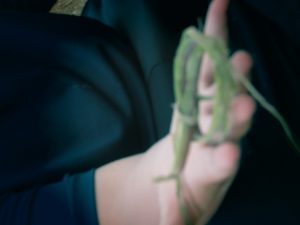
You can store it, to rehydrate it later in a bucket of water or a wet towel, or use it right away. Good job! For project ideas to make with your bark see below.
Make a rope
To make rope, fold your blackberry bark in half. Rope is made by twisting the top strand of fiber away from you…
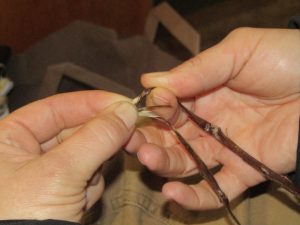
…and then bringing that twisted strand towards you and over the other strand, gripping the other strand so that they will securely change places.
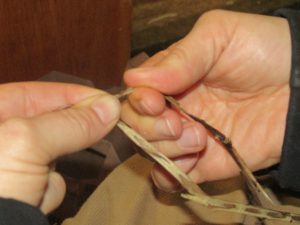
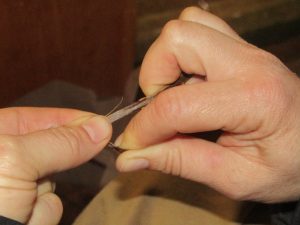
After my left thumb and forefinger have inched forward to secure the twist (see above), my right hand can let go of the strand it just twisted and start twisting the new top strand, repeating the process (see below). This locks the two strands together with a technology that dates back more than 17,000 years. This is also called making cordage, or making a 2-ply fiber.

For four-stranded braiding
Label your four strands 1, 2, 3, and 4 from left to right.

To start, cross strand #2 over strand #3.

Then cross strand #4 over strand #2…
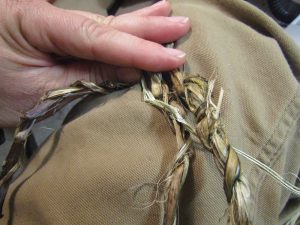
…under strand #3…
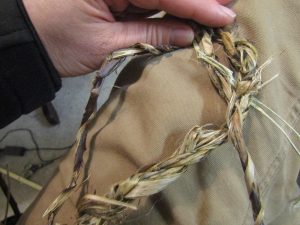
…and then turn and bring #4 back over strand #3.

Now do the same but starting from the other side, relabeling the strands as they now lie left to right #1-#4.
Take strand #1 and cross it over #2.
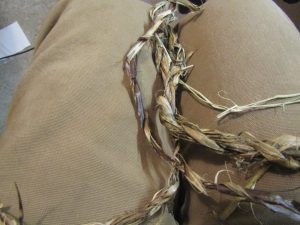
Take #1 under #3…
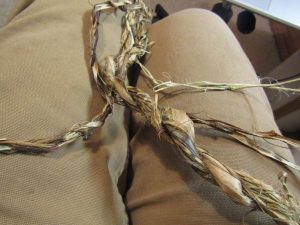
…and back over #3.
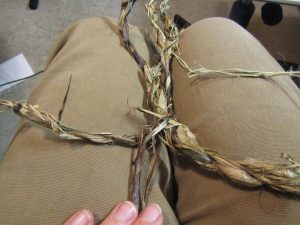
And repeat again, taking what is now your far righthand strand and bringing over it’s nearest neighbor…

…under the next one…

…and then back over the one it just went under.
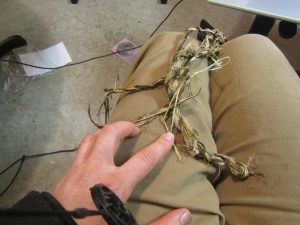
This was a very loosely done braid for demonstration purposes, but with your own you can tighten it up as desired. Good luck!
To make a basket
You will need lots of lengths of blackberry bark. Take four one-foot lengths of bark and interlace them, over under, with four additional one-foot lengths of blackberry bark. If your bark has dried, you will need to soak it in a wet towel or bucket of water to rehydrate. Take a thin strand of blackberry bark and twine in front and behind of each spoke to stabilize your plaited square. To do this you will hook the middle of your thin strand around one of your middle spokes, it doesn’t matter which side you start on. You will take the left hand piece of your thin twining strand and pass it over the spoke it encircles and then behind the next spoke bringing it down towards you again. Repeat with your new left hand strand, always bringing the two strands back to home position which is facing towards you like an upside down “U” that curves around one of the spokes. As you move to a new side, you will rotate the square so that the strands are always pointing towards you.
After one or two rounds of twining, you will flip over your square and put a glass bottle whose bottom is the same size as your square on top of your work. Bend the spokes up around the glass bottle as you go, continuing to twine in the same direction, but now on the outside of your basket with the same in front, behind pattern. The featured image shows the side pattern, called twining, and the bottom pattern, called lattice.


